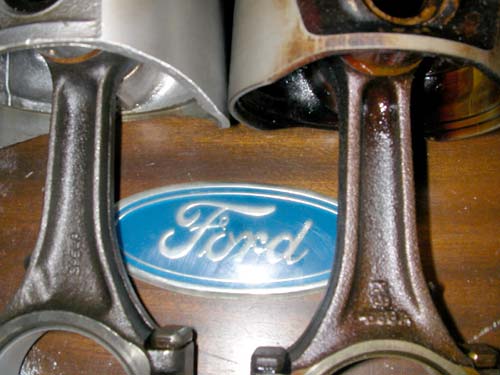205 Conrods Uncovered
Last weekend I decided to find out just what the deal is with the 205 rods found in the late model '88 '89 Ford Serrias. I had read many times that the good, easy upgrade to any 2L Pinto was the rods from a 205 block found in the Injected Serrias. However, as I reside in New Zealand, we never got injected Serrias here. (pity) But we got plenty of '88 '89 carbed versions, with 205 blocks.
I highly doubted that there would be a difference between the two. Ford probably supplied the 205 blocks but not the injection units. So Ford NZ through on Carbs. As you may have noticed I already had a 205 block in my turbo capri. But I never opened up that sucker, so I didn't know for sure whether I had the good rods or not. Because I am planning a new rebuild with forged pistons etc. I needed to know what I was going to do about the rods. I decided the best thing to do was get another block for my rebuild. Therefore saving having to take my capri engine out so early plus it's good to have a backup engine.
So I brought a 1988 Serria running a carbed 2L. Cheap as with no reg or WOF...or a rear window. It drove home sweet as and the 5 speed type9 gearbox felt mint too....another bonus.


But it's driving days were over. Not planning on keeping the car it was hacked apart by my triggerhappy mate with an anglegrinder. Engines are soooo much quicker to remove when you don't plan on saving the car. We cut the front off. Drilled out those bastard 5 star screws holding in the gearleaver. Sliced the driveshaft apart. Generally butched everything we didn't need to get the engine and box free to pull. With a bit of heave ho we had the bitch hanging from the roof. (the engine - not the missus).
***Here's a handy hint. If you ever get the chance, slice a driveshaft head off to fit in the end of your gearbox. It can be tied in for removal and instalation of your 'box without pouring shit smelling transmission fluid all over your garage floor. F_n good idea I reckon!

**Like this one!! ...yeah thats speaker cable tying it up. I couldn't find any string!!
With more care this time the head was removed, the sump taken off, and the pistons dropped out.
I spent some time carefully inscribing numbers for each rod and bearing housing.... only to find they were factory stamped with numbers on the other side!! duh. (by the way if you don't know what I'm talking about it always pays to number each rod so that it goes in the same bore, and that the bearing housings stay with the correct rod).
With the Pistons out the first thing to check was the condition of the block. By running your fingernail up and down the bores you can feel any wear, there was none. In fact, the bores were so fresh you can still see the honing marks, probably from when Ford put the engine together in 1988.

The cross scratchs are not bore wear but the original honing marks.
See the thicker webbing on the 205 rods on the right, standard pinto rod on the left-

Now for the rods. Yhep, they're the thick webbed versions! This confirms that all 205 Serria blocks have them. Great, and the 205 blocks also have thicker cyclinder walls which means they can be safely bored to 2.1 without fear of breaking into the water jacket. Or, as in my case, you can leave them be and they will withstand greater cyclinder pressures....from boostin!
I have heard that the 205 block apparantly has an extra 5kgs of strengthening. I may have to do some more weighing to see for sure.
Note:- The 205 rods are meerly a cheap and straight upgrade for a 2L. If funds allow you are still much better of with aftermarket or Cosworth items. The weakness is still in the rodbolt seat radius. This can be carefully polished and rounded to aid the strength somewhat. But if you're pulling big revs then standard rods are going to be dodgy. As I've taken the turbocharged route my rev limit is only
6000rpm. With v8 rodbolts inserted in the 205 rods, they will be sweet as.